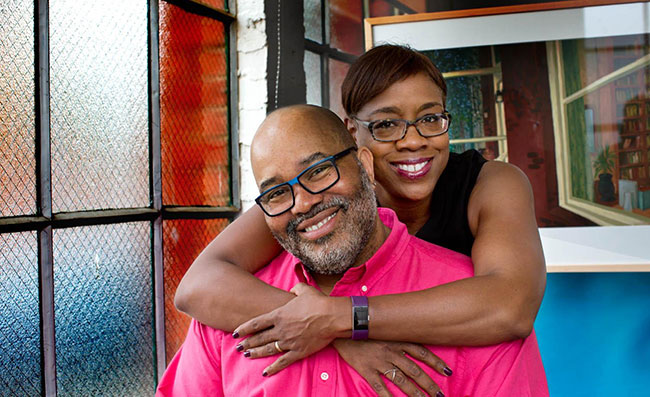James Ransome and Lesa Cline-Ransome have been writing and illustrating together and individually for many years. And their work continues to grow and evolve. Perhaps James said it best: “What makes illustrating books so exciting is that because each book has a special voice, my approach toward each is different. Whether it be through my choice of palette, design or perspective, there is always a desire to experiment and explore what makes each book unique.”

After a presentation, I had many more questions than there was time for (plus the audience was primarily younger children who had to get back to school). Lesa and James graciously agreed to answer the questions in a blog interview.
Here are the questions and the Ransomes’ responses.
Lesa, you grew up outside of Boston while James grew up in rural North Carolina. What were the primary influences each of you as you grew into an author and an artist?
Lesa: My primary influence growing up was my mother and her obsession with reading. Watching her spend nearly every waking moment reading a book taught me very early on the power of words and story. My mother often shared the stories she was reading with me and took me with her to the library. There, I began checking out my own books and decided at a very early age that I wanted to become a writer.
James: I grew up in the rural south with little access to museums or art in my school. What I did have was comic books. I loved the art in comic books like Master of Kung Fu and Mad Magazine. I lived with my grandmother up until my teenage years and her Bible was also my artistic inspiration.
What is the relationship of reading and writing? What is the function of illustrations in books, particularly for younger readers?
Lisa and James: Reading and writing are incredibly intertwined. There are times when the words tell the story and the illustrations highlight the words and there are times when the words tell a story and the illustrations tell a parallel story either by adding context or deeper meaning or humor to the text.
You met while studying at Pratt but each with a different focus, right? When — and why — did you start collaborating on children’s books?
Lesa: I was a fashion marketing major but my real love was writing. I hoped to become an editor at a fashion magazine. After graduation my first job was as a fashion copywriter at a department store. I eventually received my graduate degree in Early childhood education, taught for a short time and when I was home with my first child, decided to start writing my first book, Satchel Paige.
James: Lesa and I met in college during our sophomore year at Pratt Institute in Brooklyn, New York. I was an illustration major. My first illustration jobs after I graduated were editorial work and by luck I met someone who introduced me to Richard Jackson at Orchard Books who offered me my first book, Do Like Kyla. Nearly 10 years later, after I’d illustrated probably 20 books, Lesa and I collaborated on our first book together, Satchel Paige.
What made you decide to go into books for young readers?
Lesa: Between my love of writing, my children’s literature classes in grad school, teaching, being married to a children’s book illustrator and starting a family, it seems like I had no choice! I also love the idea of telling stories, especially of historical figures, in bite sized pieces and focusing on the moments in childhood that impact decisions people make in the future.
James: Probably from my early love of comic books, I have always liked making images in a series. In my portfolio I created a series of images of a day in the life of a young girl and it was those images I showed to an art director that led to me doing my first children’s book.
Before She Was Harriet is a fresh take on Harriet Tubman. How did you decide to present this iconic woman as you did? How does research, revision and rewriting factor into your work, Lesa?
There were already so many amazing books about Harriet that I had to find a new way to tell her story. When James told me he had found in his reading, stories of her many other lives, I knew then that may be our story. I often let research guide the story rather than finding research to support a story. By letting research lead the way, I keep myself open to new discoveries and the many twists and turns I often find.
Revision is hard for any writer but it is the most necessary part of the writing process. It helps me to see my work as a reader might and trust that making changes help to move the story forward. Often after I compare my first draft with the final version, I am amazed at the transformation.
James, how did you research the illustrations for this book and other biographical and historical works? Is visual accuracy as important as historical accuracy or does it exist to support the text?
Because I’ve illustrated a number of books on the subject of slavery, I have a great reference library. I would say that for me visual accuracy is slightly more important than historical accuracy because as a visual person, I will always lean towards creating an interesting picture.
[NOTE: On February 12th, the ALA Youth Media Awards announced that James Ransome received a 2018 Coretta Scott King Illustrator Honor for Before She Was Harriet . Congratulations!]
Lesa, how do you typically collaborate with James or other illustrators who illustrate your books?
Lesa: People often have the idea that as a married couple, we work blissfully side by side to create our books, but the truth is that our collaboration typically begins and ends with brainstorming. Together we come up with projects that we want to work on together and then I begin the research, writing and editing with the editor. Once that process is complete, the manuscript is with the publisher until the illustrator is ready to begin illustrating which can take anywhere from one to three years later. When I work with illustrators other than James, I typically don’t have any contact with them until the work is nearly completed. I enjoy seeing the work in stages when I am working with James and occasionally weighing in.
What are the steps to create a picture book?
James: Like Lesa, each book begins with research. I do some reading, but mainly I gather books, photographs and visit places to get as much information as possible. I then do thumbnail sketches in my sketchbooks of my ideas. From there, I create a dummy book, which is the same size and number of pages the actual book will be. I tape down the text on each page and sketch my ideas. I get feedback from the art director and make necessary revisions. Then I hire models (usually family members and friends) to model for various parts, take photographs of them acting out the parts. I select my favorite photos and draw those onto tracing paper, often using several layers for each character and background. Then using a lightbox, I draw it all onto one sheet of paper. I then start painting using acrylic, watercolor, or oils. Recently I have used gouache and even collage. It takes anywhere from three to six months to create each book.
Tell us about your children and any influence they’ve had on your work (including Nola, of course!).
Lesa and James: We have four children. Our oldest, Jaime (24), is an assistant curator at a gallery in Syracuse. Our second, Maya (22), is a graphic designer in NYC. Our third, Malcolm (21), is going into his last year at Syracuse University as an Industrial Design major and our youngest, Leila (17), is a senior in high school and will be going away to college next fall. We also have our baby Nola, a Saint Bernard who is 9 years old. I’m not sure how much influence they’ve had on my work, but they can be excellent assistant editors and art directors when we need feedback. They did inspire our book Germs, because they never wanted to wash their hands when they were young.
What suggestions would you give to parents and/or teachers to encourage reading?
Lesa and James: Read! If kids see you enjoy reading, they will read. If kids see books and newspapers hold inside them fascinating stories, articles and information, they will want to read it for themselves.
What’s next for Lesa and James, together and individually?
Lesa: My debut novel Finding Langston, the story of a boy in 1946 Chicago who migrated from rural Alabama and finds refuge in a library and the words of Langston Hughes will be released this summer. James and I also have a new picture book coming out this summer entitled Game Changers: The Story of Venus and Serena Williams
James: I just completed a picture book I wrote and illustrated entitled The Bell Rang about a boy who escapes slavery and the family he leaves behind. I have begun work on a book about the History of Football.
About the Author
Reading Rockets’ children’s literature expert, Maria Salvadore, brings you into her world as she explores the best ways to use kids’ books both inside — and outside — of the classroom.

